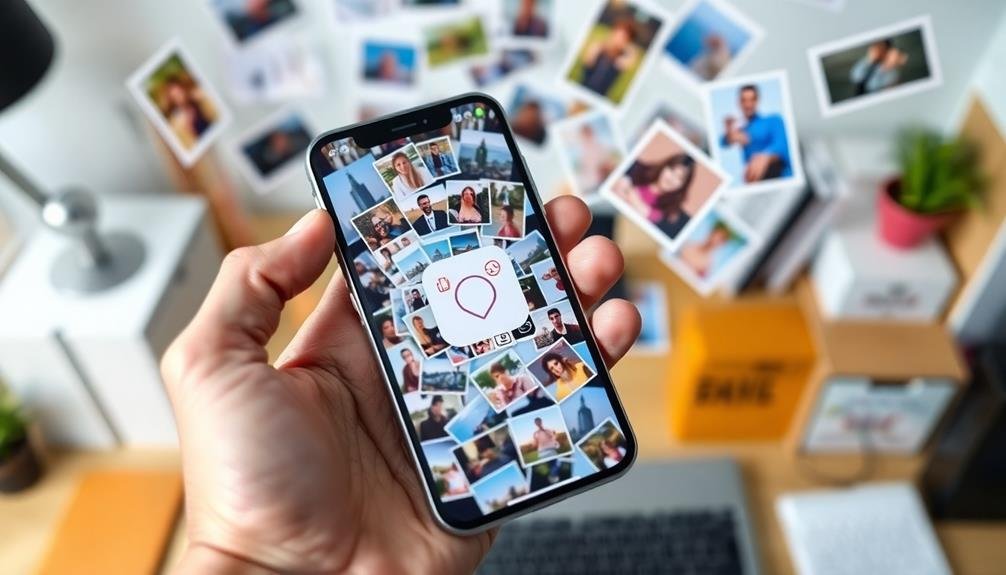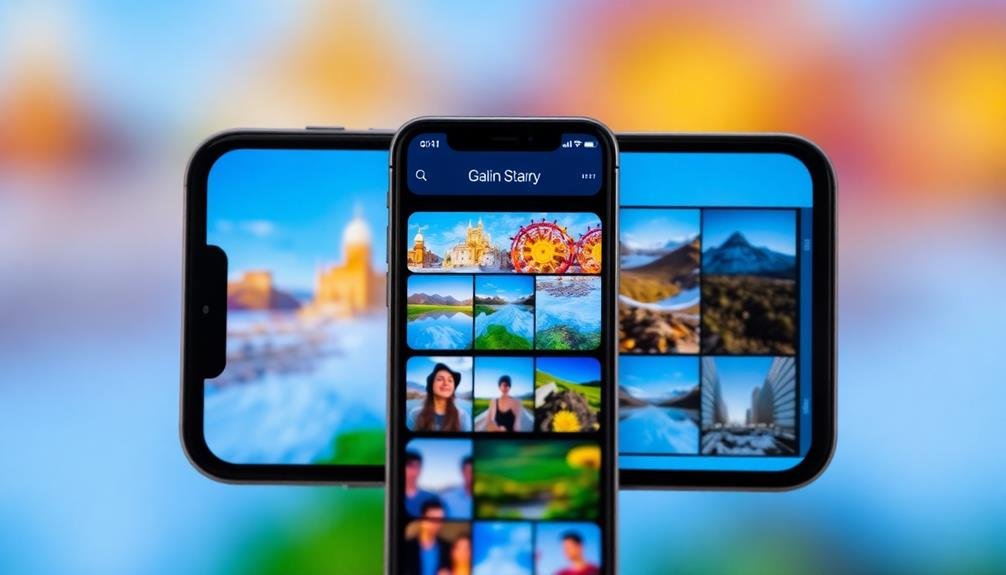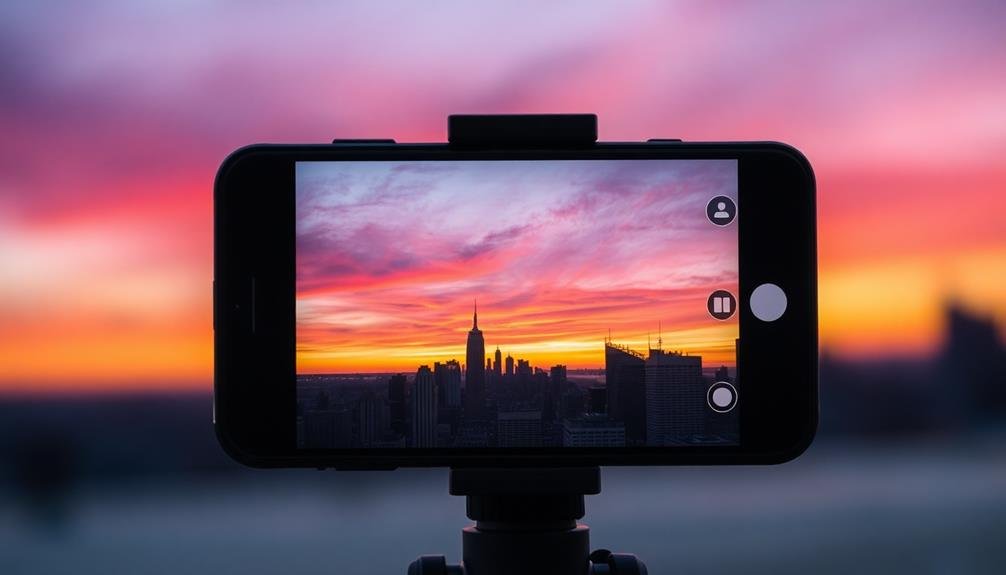Decluttering your mobile photos offers numerous benefits. You'll free up valuable storage space, improving your device's performance and battery life. By organizing your images, you'll enhance search efficiency, making it easier to find specific photos when you need them. Creating meaningful albums allows you to relive cherished memories and share them effortlessly with loved ones. Prioritizing high-quality images guarantees your collection remains visually appealing and emotionally significant. Regular decluttering routines help maintain a streamlined photo library, reducing digital clutter stress. By implementing these essential tips, you'll not only optimize your device but also rediscover forgotten moments and simplify your digital life. Explore further to access the full potential of your photo collection.
Free Up Storage Space

Freeing up storage space is often the primary motivation for decluttering your mobile photos. As you snap countless pictures, your device's storage can quickly fill up, leaving little room for new apps, videos, or essential updates. By removing duplicate, blurry, or unwanted images, you'll reclaim valuable space and improve your phone's performance.
Start by identifying and deleting obvious candidates: screenshots you no longer need, memes you've already shared, and multiple versions of the same photo.
Next, tackle those burst shots you took to capture the perfect moment. Choose the best one and discard the rest.
Don't forget about your messaging apps; they often store received photos and videos, eating up space without you realizing it.
Consider using cloud storage services to back up your important photos. This allows you to keep your memories safe while freeing up local storage.
Many services offer automatic syncing, ensuring you won't lose any precious moments. Once your photos are safely backed up, you can confidently remove them from your device, knowing they're just a download away when needed.
Improve Photo Search Efficiency

By improving your photo search efficiency, you'll save time and frustration when looking for specific images.
Start by organizing your albums effectively and tagging photos with relevant metadata like location, date, and event details.
These steps will greatly speed up image retrieval, allowing you to find the exact photo you need in seconds rather than minutes.
Faster Image Retrieval
In light of the ever-growing photo collections on our smartphones, improving search efficiency has become essential. Faster image retrieval is a vital aspect of this process, allowing you to find specific photos quickly and easily.
To speed up image retrieval, start by organizing your photos into albums or folders based on themes, events, or dates. This simple step can greatly reduce search time.
Next, take advantage of your phone's facial recognition feature to tag people in your photos, making it easier to find images of specific individuals.
Use descriptive file names and add relevant keywords or tags to your photos. This practice enhances your phone's ability to locate images based on search terms.
Additionally, utilize your device's location services to automatically geotag photos, enabling you to search for images by location.
Consider using third-party photo management apps that offer advanced search capabilities, such as object recognition or color-based searches. These tools can further streamline your photo retrieval process.
Regularly back up and sync your photos to cloud storage services, ensuring that you can access and search your entire photo collection across multiple devices, even when your phone isn't available.
Enhanced Album Organization
Enhanced album organization is an essential step in improving photo search efficiency. When you take the time to organize your photos into well-structured albums, you'll find it much easier to locate specific images when you need them.
Start by creating a logical album hierarchy based on categories that make sense to you, such as events, locations, or dates. Consider using descriptive album names that are easy to remember and search for.
Don't hesitate to create sub-albums within main categories to further refine your organization. For instance, within a "Vacations" album, you might've sub-albums for different trips or destinations.
Take advantage of your device's built-in features, such as facial recognition or location tagging, to automatically sort photos into relevant albums.
Regularly review and update your album structure to maintain its relevance and usefulness.
Improved Metadata Tagging
Improved metadata tagging goes hand in hand with enhanced album organization to boost your photo search efficiency. By adding relevant tags to your images, you'll create a powerful search system that makes finding specific photos a breeze. Start by using descriptive keywords for people, places, events, and objects in your photos. Don't forget to include emotions or abstract concepts that capture the essence of the image.
Take advantage of your phone's built-in AI capabilities to automatically tag faces, objects, and locations. Many photo apps also offer advanced tagging features, allowing you to create custom tags or use voice commands for quick labeling. Remember to be consistent with your tagging system to maximize its effectiveness.
Here's a quick guide to effective metadata tagging:
| Tag Category | Examples |
|---|---|
| People | Family, Friends, Coworkers |
| Places | Cities, Landmarks, Nature |
| Events | Weddings, Holidays, Parties |
| Objects | Food, Animals, Architecture |
| Emotions | Happy, Sad, Excited |
Enhance Device Performance

Have you ever noticed your phone slowing down as your photo gallery grows? That's because storing thousands of images can greatly impact your device's performance.
By decluttering your mobile photos, you'll free up valuable storage space and boost your phone's speed. When you remove unnecessary photos, your device doesn't have to work as hard to index and manage them. This reduces the strain on your phone's processor and memory, resulting in faster app launches and smoother overall operation.
You'll also save battery life, as your phone won't waste energy maintaining a bloated photo library.
Decluttering helps your device's backup and sync processes run more efficiently. With fewer photos to upload, you'll experience quicker backups and reduced data usage. This is especially beneficial if you're on a limited data plan or frequently use cloud storage services.
Rediscover Forgotten Memories

While decluttering your mobile photos improves your device's performance, it also offers a surprising benefit: rediscovering forgotten memories. As you sift through your digital collection, you'll stumble upon images you'd completely forgotten about, rekindling precious moments from the past. This process can be both nostalgic and enlightening, helping you appreciate experiences you might've overlooked.
Take time to revisit these memories and consider their significance. You might find inspiration for future adventures, reconnect with old friends, or gain a fresh perspective on your personal growth. Don't rush through this process; savor each rediscovered photo and the emotions it evokes.
To make the most of your rediscovered memories:
- Create themed albums for easy browsing
- Share forgotten gems with friends and family
- Use rediscovered photos as prompts for journaling
- Print and frame your favorite rediscovered images
- Use old photos to inspire new creative projects
Streamline Sharing Process

Once you've decluttered your photo collection, sharing your favorite images becomes a breeze. You'll find it easier to locate and select the photos you want to share, saving time and reducing frustration. With a streamlined gallery, you can quickly create albums or collections for specific events or themes, making it simple to share multiple photos at once.
Many photo management apps offer advanced sharing features that work best with an organized library. You'll be able to take full advantage of these tools, such as facial recognition for easy tagging and location-based sorting for travel photos. Here's a quick comparison of popular photo sharing methods:
| Method | Pros | Cons |
|---|---|---|
| Social Media | Wide reach, instant feedback | Privacy concerns, compression |
| Cloud Services | High quality, secure | Requires account, potential costs |
| Direct Share | Personal, full control | Limited audience, device-dependent |
Reduce Digital Clutter Stress

Managing your digital photos isn't just about organization; it's also about your mental well-being. A cluttered photo library can lead to stress, anxiety, and a feeling of being overwhelmed. When you can't find the images you need or are constantly bombarded with unnecessary photos, it affects your productivity and peace of mind.
To reduce digital clutter stress, start by setting aside time to regularly review and delete unwanted photos. Create a system for categorizing your images, making them easier to locate when needed. Consider using cloud storage to free up space on your device while keeping your memories safe and accessible.
Here are key benefits of reducing digital photo clutter:
- Improved mental clarity and focus
- Easier access to important memories
- Faster device performance
- Reduced storage costs
- Enhanced creativity through organized inspiration
Simplify Cloud Backup Management

To simplify cloud backup management for your mobile photos, you'll need a streamlined approach. Start by choosing a single cloud service that best suits your needs, such as Google Photos, iCloud, or Dropbox. Consolidating your backups to one platform reduces complexity and makes it easier to keep track of your photos.
Next, enable automatic backups on your chosen service. This guarantees your photos are consistently saved without manual intervention. Set up Wi-Fi-only backups to conserve mobile data and prevent unexpected charges.
Regularly review and delete unnecessary backups to free up cloud storage space. Many services offer tools to identify duplicate or low-quality images, making this process more efficient. Consider upgrading your storage plan if you frequently run out of space.
Organize your backed-up photos into albums or folders for easy access. Use descriptive names and tags to make searching for specific images simpler. Take advantage of facial recognition and location tagging features to further enhance organization.
Lastly, periodically check your backup settings to verify they're still aligned with your needs. As your photo collection grows, you may need to adjust sync frequency or storage options.
Identify Duplicate Photos

With your cloud backup system in place, it's time to tackle the issue of duplicate photos cluttering your mobile device. Identifying and removing duplicate images can free up valuable storage space and make browsing your photo gallery more efficient.
Many smartphones now come with built-in duplicate detection features, but you can also use third-party apps for a more thorough scan.
To effectively identify duplicate photos, consider these key points:
- Look for exact duplicates first, as they're easiest to spot
- Check for similar images taken in burst mode or rapid succession
- Compare file sizes and dates to differentiate between originals and copies
- Use AI-powered apps to detect visually similar images, not just exact matches
- Don't forget to scan both your device storage and cloud backups
Once you've identified duplicates, carefully review them before deletion. Sometimes, slight variations in quality or composition might make one version preferable.
Remember to keep the highest quality version of each photo. By regularly identifying and removing duplicate photos, you'll maintain a cleaner, more organized photo collection that's easier to navigate and share with others.
Create Meaningful Photo Albums

Create meaningful photo albums by organizing your pictures into themed collections that capture specific events, places, or emotions.
Arrange your photos chronologically to tell a compelling story of your experiences over time.
Share these curated albums with family and friends to relive cherished memories together and strengthen your connections.
Organize by Theme
Countless photos can be transformed into a meaningful collection by organizing them into themed albums. This approach helps you make sense of your digital memories and makes it easier to find specific images when you need them. By creating albums based on themes like vacations, holidays, or special events, you'll bring structure to your photo library and rediscover forgotten moments.
When organizing by theme, consider these popular categories:
- Family gatherings and celebrations
- Travel and adventures
- Hobbies and interests
- Seasonal photos (spring, summer, fall, winter)
- Milestones and personal achievements
Start by reviewing your photos and identifying common themes. Create albums with descriptive names that reflect the content. As you sort your images, be selective and only keep the best shots that truly capture the essence of each theme.
This process not only declutters your photo library but also helps you relive cherished memories.
Don't forget to use tags or keywords to further categorize your photos within each album. This additional layer of organization will make it even easier to locate specific images in the future.
Chronological Storytelling
Chronological storytelling offers a powerful way to organize your mobile photos and create meaningful albums. By arranging your images in the order they were taken, you'll create a natural narrative that captures the progression of events, experiences, and memories.
Start by selecting a specific timeframe, such as a vacation, a year in your life, or a child's growth. Sort your photos by date and begin curating your album. As you go through the images, you'll notice how they naturally tell a story, showing changes and developments over time.
Don't feel obligated to include every photo; choose the ones that best represent key moments and milestones. Consider adding brief captions or notes to provide context and enhance the storytelling aspect. This approach not only helps you declutter your photo library but also creates a more engaging and meaningful collection.
Chronological albums are particularly effective for documenting life events, travel experiences, or personal growth journeys. They allow you to revisit memories in sequence, reliving the emotions and experiences as they unfolded.
Share With Loved Ones
While organizing your photos chronologically tells your personal story, sharing these curated collections with loved ones adds a new dimension to your decluttering efforts. By creating meaningful photo albums, you're not just preserving memories for yourself but also fostering connections with family and friends.
Start by selecting the best images that represent significant moments or themes. Create digital albums using cloud storage services or photo-sharing platforms. These allow you to easily share and collaborate with others, adding captions and comments to enrich the storytelling experience.
Consider these benefits of sharing your decluttered photo collections:
- Strengthens family bonds through shared memories
- Encourages conversation and storytelling
- Preserves family history for future generations
- Provides a sense of nostalgia and emotional connection
- Allows distant relatives to stay connected and involved
As you share your curated albums, you'll likely receive feedback and additional context from loved ones. This interaction can help you further refine your collection, identifying the most meaningful images and potentially uncovering forgotten stories.
Prioritize High-Quality Images

When sorting through your mobile photos, zero in on the high-quality images that truly stand out. These are the photos you'll want to keep and cherish. Look for sharp focus, good lighting, and compelling compositions.
Reflect on the emotional value of each image as well – sometimes a slightly blurry photo can hold great sentimental worth.
As you prioritize, be ruthless with duplicates. Keep only the best version of similar shots, deleting the rest. This approach greatly reduces clutter and makes it easier to find your favorite photos later.
Pay attention to resolution too. Higher-resolution images generally offer better quality and more flexibility for printing or editing.
Don't forget to reflect on the uniqueness of each photo. A well-composed shot of a rare moment or special event might be worth keeping over technically superior but commonplace images.
Use your photo app's rating or favoriting system to mark your top picks, making future sorting sessions easier. By focusing on quality over quantity, you'll create a curated collection of images that truly represent your best memories and experiences.
Organize Photos by Date

One of the most effective ways to declutter your mobile photos is by organizing them chronologically. This method allows you to easily locate specific images based on when they were taken, making it simpler to manage your photo library.
Most smartphones automatically sort photos by date, but you can take this organization a step further by creating folders for different time periods, such as months or years.
When you organize your photos by date, you'll find it easier to:
- Locate specific memories from events or trips
- Track your personal growth and changes over time
- Create themed albums for different periods of your life
- Identify and remove duplicate images more efficiently
- Share photos from particular timeframes with friends and family
To get started, use your phone's built-in photo app or a third-party organizing tool to sort your images by date.
Then, create folders for different time periods and move your photos accordingly.
Don't forget to back up your organized photos to the cloud or an external hard drive to guarantee you don't lose your precious memories.
Implement Regular Decluttering Routine

After organizing your photos by date, maintaining a clutter-free photo library requires ongoing effort.
Implement a regular decluttering routine to keep your mobile photos manageable and guarantee you're not wasting storage space on unnecessary images.
Set a recurring reminder on your phone to review and delete unwanted photos every week or month. During these sessions, focus on removing duplicates, blurry shots, and images you no longer need.
Be ruthless in your selection process – if a photo doesn't spark joy or serve a purpose, it's time to let it go.
Consider adopting a "one in, one out" policy for your photo library. For every new photo you take, delete an old one that's no longer relevant or meaningful.
This practice helps maintain a constant number of photos and prevents your library from growing out of control.
Use your phone's built-in tools or third-party apps to identify and remove duplicate photos automatically.
These tools can save you time and guarantee you're not overlooking any redundant images.
Frequently Asked Questions
How Can I Safely Delete Photos From My Device Without Losing Them Permanently?
To safely delete photos from your device without permanent loss, you'll want to back them up first. Use cloud storage services like Google Photos or iCloud, or transfer them to your computer before deleting from your phone.
What Tools or Apps Are Best for Organizing and Decluttering Mobile Photos?
You'll find several great options for organizing your mobile photos. Try Google Photos, Apple's Photos app, or Slidebox for easy sorting. These apps offer features like facial recognition, automatic categorization, and swipe-to-delete functionality to streamline your decluttering process.
How Do I Transfer Photos From My Mobile Device to a Computer?
You can transfer photos from your mobile device to your computer in several ways. Use a USB cable to connect directly, sync via cloud services like iCloud or Google Photos, or email photos to yourself. Choose the method that's most convenient for you.
Can I Recover Accidentally Deleted Photos During the Decluttering Process?
You can often recover accidentally deleted photos during decluttering. Check your device's "Recently Deleted" folder first. If they're not there, try using photo recovery apps or software. Act quickly, as deleted photos may be overwritten over time.
How Do I Protect My Privacy When Sharing or Backing up Decluttered Photos?
To protect your privacy when sharing or backing up photos, you'll want to use secure cloud services, enable two-factor authentication, and be selective about what you share. Don't forget to review privacy settings and remove location data when necessary.
In Summary
You've now got the tools to declutter your mobile photos effectively. By following these tips, you'll free up space, boost your device's performance, and rediscover cherished memories. Remember, it's not just about deleting; it's about curating your digital life. Make photo organization a regular habit, and you'll always have a streamlined, meaningful collection at your fingertips. Don't wait – start decluttering today and enjoy the benefits of a well-organized photo library.





Leave a Reply